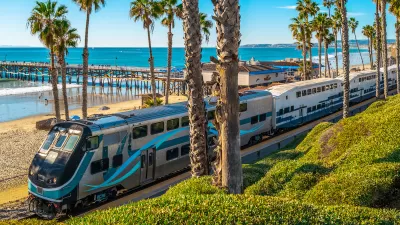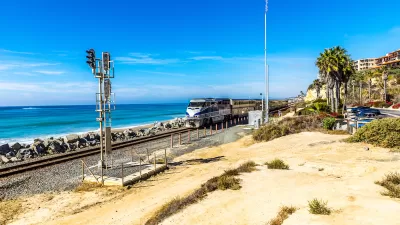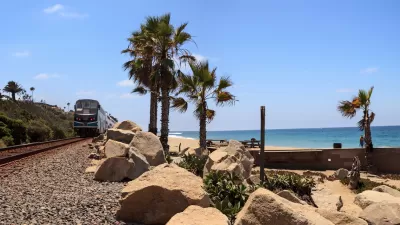With a patchwork of management and local agencies involved, the imperiled rail corridor has no unified plan for improving or relocating tracks impacted by coastal erosion.

The rail corridor spanning 351 miles between San Luis Obispo and San Diego on the Southern California coast faces an uncertain future as erosion and sea level rise threaten the coastline that much of the tracks run along. As Melanie Curry explains in Streetsblog California, the line “serves as an important passenger connection for points between Santa Barbara and San Diego, and the route is also a key freight corridor, directly serving the ports of San Diego and Port Heuneme [sic].”
With the southern end of the corridor “closed more than it’s been open” in the last few months, “The [California] legislature this year formed a subcommittee to discuss the considerable problems facing this crucial rail route, and today held a second hearing on the topic (the first was held in May).”
The subcommittee didn’t reach any conclusions about how to move forward, Curry adds. “Further threats from sea level rise and rain seepage will continue their inexorable work to erode the cliffs. And a very wide range of agencies and operators have some role in maintaining rails and service, and in planning future work - but there is no clear leader.” Curry notes that “Most of the emergency work over the last 23 months has been in response to landslides from properties owned by private individuals above the cliffs, and has ranged from building retaining walls to adding riprap and sand along the coast.”
Darrel Johnson, the CEO of Orange County Transportation Authority (OCTA), said it became obvious during the hearings that “that the state has a very clear process for highway emergencies. This does not exist for publicly owned railroads.”
FULL STORY: What Is to Become of Southern California’s Coastal Rail Corridor?

Alabama: Trump Terminates Settlements for Black Communities Harmed By Raw Sewage
Trump deemed the landmark civil rights agreement “illegal DEI and environmental justice policy.”

Planetizen Federal Action Tracker
A weekly monitor of how Trump’s orders and actions are impacting planners and planning in America.

Why Should We Subsidize Public Transportation?
Many public transit agencies face financial stress due to rising costs, declining fare revenue, and declining subsidies. Transit advocates must provide a strong business case for increasing public transit funding.

Understanding Road Diets
An explainer from Momentum highlights the advantages of reducing vehicle lanes in favor of more bike, transit, and pedestrian infrastructure.

New California Law Regulates Warehouse Pollution
A new law tightens building and emissions regulations for large distribution warehouses to mitigate air pollution and traffic in surrounding communities.

Phoenix Announces Opening Date for Light Rail Extension
The South Central extension will connect South Phoenix to downtown and other major hubs starting on June 7.
Urban Design for Planners 1: Software Tools
This six-course series explores essential urban design concepts using open source software and equips planners with the tools they need to participate fully in the urban design process.
Planning for Universal Design
Learn the tools for implementing Universal Design in planning regulations.
Caltrans
Smith Gee Studio
Institute for Housing and Urban Development Studies (IHS)
City of Grandview
Harvard GSD Executive Education
Toledo-Lucas County Plan Commissions
Salt Lake City
NYU Wagner Graduate School of Public Service





























